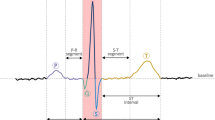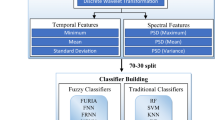Abstract
This paper proposes a method for electrocardiogram (ECG) heartbeat recognition using classification enhancible grey relational analysis (GRA). The ECG beat recognition can be divided into a sequence of stages, starting with feature extraction and then according to characteristics to identify the cardiac arrhythmias including the supraventricular ectopic beat, bundle branch ectopic beat, and ventricular ectopic beat. Gaussian wavelets are used to enhance the features from each heartbeat, and GRA performs the recognition tasks. With the MIT-BIH arrhythmia database, the experimental results demonstrate the efficiency of the proposed non-invasive method. Compared with artificial neural network, the test results also show high accuracy, good adaptability, and faster processing time for the detection of heartbeat signals.






Similar content being viewed by others
References
Acharya UR, Kumar A, Bhat PS, Lim CM, Lyengar SS (2004) Classification of cardiac abnormalities using heart rate signals. Med Biol Eng Comput 42(3):288–293
Chang W-C (2000) A comprehensive study of grey relational generating. J Chinese Grey Assoc 1:53–62
de Chazal P, O’Dwyer M, Reilly RB (2004) Automatic classification of heartbeats using ECG morphology and heartbeat interval features. IEEE Trans Biomed Eng 51(7):1196–1206
Dickhaus H, Heinrich H (1996) Classifying biosignals with wavelet networks—a method for noninvasive diagnosis. IEEE Eng Med Biol September/October:103–111
Goldberger AL, Amaral LAN, Glass L, Hausdorff JM, lvanov PCh, Mark RG, Mietus JE, Moody GB, Peng CK, Stanley HE (2000) PhysioBank, Physio Toolkit, and PhysioNet: components of a new research resource for complex physiologic signals. Circulation 101(23):e215–e220 [Circulation electronic Pages; http://www.circ/cgi/content/full/101/23/e215]; (June 13)
Hu Y-H, Palreddy S, Tompkins W (1997) A patient adaptable ECG beat classifier using a maxture of experts approach. IEEE Trans Biomed Eng 44:891–900
Huang Y-C, Huang C-M (2002) Evolving wavelet network for power transformer condition monitoring. IEEE Trans Power Delivery 17(2):412–416
Lin W-M, Lin C-H, Tasy M-X (2005) Transformer-fault diagnosis by integrating field data and standard codes with training enhancible adaptive probabilistic network. IEE Proc Gener Transm Distrib 152(3):335–341
Luo G, Osypiw D, Irle M (2000) Application of time-scale Gaussian wavelet based fast algorithm for vibration transients detection. IEE Semin Time-Scale Time-Freq Anal Appl 29 February:pp 16/1–16/7
Minami K, Nakajima H, Toyoshima T (1999) Real-time discrimination of ventricular tachyarrhythmia with Fourier-transform neural network. IEEE Trans Biomed Eng 46(2):179–185
Osowski S, Linh TH (2001) ECG beat recognition using fuzzy hybrid neural network. IEEE Trans Biomed Eng 48(11):1265–1271
Qin S, Ji Z, Zhu H (2003) The ECG recording analysis instrumentation based on virtual instrument technology and continuous wavelet transform. In: Proceedings of the 25th annual international conference of the IEEE EMBS Cancun, Mexico, 17–21 September 2003, pp 3176–3179
Seng TL, Khalid M, Tusof R (2002) Adaptive GRNN for the modeling of dynamic plants. In: Proceedings of the 2002 IEEE international symposium on intelligent control, Vancouver, Canada, 27–30 October 2002, pp 217–222
Silipo R, Marchesi C (1998) Artificial neural networks for automatic ECG analysis. IEEE Trans Signal Process 46(5):1417–1425
Wang Y, Zhu Y-S, Thakor NV, Xu Y-H (2001) A short-time multifractal approach for arrhythmias detection based on fuzzy neural network. IEEE Trans Biomed Eng 48(9):989–995
Wu JH, Chen C-B (1999) An alternative form for grey relational grades. J Grey Syst 1:7–12
Acknowledgment
This work is supported in part by the National Science Council of Taiwan under contract number: NSC 93-2614-E-244-001 (December 1 2004–July 31 2005). The author would like to thank associate editors of Medical & Biological Engineering & Computing and reviewers for reviewing the manuscript and providing the suggestion.
Author information
Authors and Affiliations
Corresponding author
Rights and permissions
About this article
Cite this article
Lin, CH. Classification enhancible grey relational analysis for cardiac arrhythmias discrimination. Med Bio Eng Comput 44, 311–320 (2006). https://doi.org/10.1007/s11517-006-0027-3
Received:
Accepted:
Published:
Issue Date:
DOI: https://doi.org/10.1007/s11517-006-0027-3




